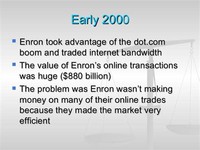Facts about Enron

Shortly after emerging from bankruptcy in November 2004, Enron's new board of directors sued 11 financial institutions for helping Lay, Fastow, Skilling and others hide Enron's true financial condition.

Eight former Enron executives testified, including star witness Andrew Fastow, against Lay and Skilling.

The baseball stadium Enron Field in Houston, Texas, named after the company, was opened on April 7, 2000, at a game where Kenneth Lay threw out the first pitch.

The trials surrounding the Enron scandal revealed many details of the accounting fraud and insider trading that had occurred at Enron, and set a number of precedents.

The Houston Astros Major League Baseball team paid Enron $5 million to withdraw its naming rights after the company collapsed, and the field was renamed Astros Field.

Enron filed for bankruptcy protection in the Southern District of New York and selected Weil, Gotshal & Manges as its bankruptcy counsel.
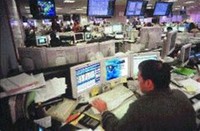
EnronOnline closed down for online trading on the morning of November 28, 2001, four days before Enron filed for bankruptcy.

By pursing an aggressive investment strategy, Enron became the biggest wholesaler of gas and electricity, trading $27 billion in a quarter.

October 17, 2001, Enron announced that its third-quarter results were negative due to one-time charges of over $1 billion.

Enron Creditors Recovery Corporation (formerly Enron Corporation, former NYSE ticker symbol ENE) was an American energy company based in Houston, Texas.

EnronOnline allowed market participants to see prices on their computer screens and to do business more simply.

Enron traces its roots to the Northern Natural Gas Company, which was formed in 1932 in Omaha, Nebraska.

EnronOnline spawned several other e-commerce websites including http://www.DealBench.com www.DealBench.com, an acquisition and divestiture tool still operating today.

Enron conducted institutionalized, systematic, and creatively planned accounting fraud.

The firm was found guilty of obstruction of justice in 2002 for destroying documents related to the Enron audit and was forced to stop auditing public companies.

The trial of Arthur Andersen LLP on charges of obstruction of justice related to Enron helped to expose accounting fraud at WorldCom.
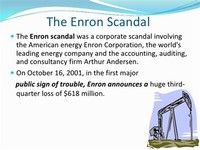
At the beginning of 2001, the Enron Corporation was the world's dominant energy trader, with reported revenues of nearly $101 billion for 2000..

At the same time, the general public and Enron's investors were encouraged to buy the stock and assured that its price would continue to climb until it reached the range of $130 to $140.

Debt-ridden Enron subsisted largely on the continual infusion of investor capital which resulted from the steadily rising price of its stock.

Enron's collapse contributed to the creation of the U.S. Sarbanes-Oxley Act (SOX), signed into law on July 30, 2002, considered the most significant change to federal securities laws since FDR's New Deal in the 1930s.

Many of Enron's debts and the losses that it suffered were not reported in its financial statements.

The lawsuits against Enron's directors were notable because the directors settled by paying significant sums of money personally.

EnronOnline was regarded as an impressive trading tool, but because Enron was either buying, selling, or trading in every transaction, its costs increased over time until they became prohibitive.

Enron's European operations filed for bankruptcy on November 30, 2001, and it sought Chapter 11 protection in the U.S. two days later on December 2, 2001.

Enron employees and investors in pension funds, such as the University of California, lost more than 25 billion dollars.

Enron's sole electric utility in the United States, Portland General Electric, was spun off as an independent company in 2006, with its shares disbursed to creditors.

Enron was originally involved in transmitting and distributing electricity and gas throughout the United States.

The 2003 non-fiction book Enron: The Smartest Guys in the Room, by Bethany McLean and Peter Elkind, was a bestseller.

On August 14, 2001, Jeffrey Skilling, the chief executive of Enron, resigned after selling 450,000 shares for around $33 million By August 15, 2001, Enron's stock price had fallen to $42.

Under Skilling, Enron adopted mark to market accounting, in which anticipated future profit from any deal was recorded as profit already realized, even when the deal later resulted in a loss.

Former Enron CFO Andrew Fastow, the mastermind behind Enron's complex network of offshore partnerships and questionable accounting practices, was sentenced to ten years in prison and a penalty of US $23.8 million.

Enron was able to obtain nearly $20 million dollars to distribute to its creditors as a result of the megaclaims litigation.

A number of bank executives profited personally from ownership of Enron shares.

The scandal caused the dissolution of Enron’s auditor, Arthur Andersen, one of the world's top accounting firms at the time.

Despite this, Enron's profit margin had stayed at a modest average of about 2.1 percent, and its share price had dropped by over 30 percent since the same quarter of 2000.

Fallout from the scandal quickly extended beyond Enron and all those formerly associated with it.

Fortune named Enron "America's Most Innovative Company" for six consecutive years.

Lay's wife, Linda, has been accused of selling 500,000 shares of Enron stock, totaling $1.2 million, on November 28, 2001, just ten minutes before news of Enron’s problems became public.

Enron stock, which had been selling for $80 - $90 per share, suddenly lost its value, causing investors to lose millions of dollars.

Enron was named "America's Most Innovative Company" by Fortune magazine for six consecutive years, from 1996 to 2001.

The main commodities offered on EnronOnline were natural gas and electricity, although there were 500 other products including credit derivatives, bankruptcy swaps, pulp, gas, plastics, paper, steel, metals, freight, and TV commercial time.

Anatomy of Greed, written by Brian Cruver, and published in 2002, was the first insider account of events surrounding Enron's collapse.

On November 28, 2001, Dynegy Inc. backed out of a proposed acquisition of the company and Enron's credit rating fell to junk status.

Enron had been considered a blue chip stock, and its fall was an unprecedented and disastrous event in the financial world.

Kenneth Lay repeatedly issued statements and appeared before investors to assure them that Enron was headed in the right direction.

Early in November 2001 it became known that the Enron management had been aggressively pursuing new investment or an outright buyout.

Perhaps one of Enron's few remaining assets is DealBench, an online transaction and divestiture service, once part of the now defunct EnronOnline.

Enron's party insolvency took the form of a liquidation, rather than a restructuring, as initially expected.

In 1998 Enron entered the water sector, creating the Azurix Corporation, which it part-floated on the New York Stock Exchange in June 1999.

Enron’s ties to the Bush administration assured that its views would be heard in Washington.
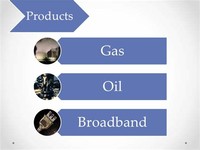
Enron manufactured gas valves, circuit breakers, thermostats, and electrical equipment in Venezuela through INSELA SA, a 50-50 joint venture with General Electric.

In August 2000, Enron's stock price peaked at $90 and Enron executives, who knew about the hidden losses, began to sell their stock.

Enron’s fiscal health became secondary to manipulating its stock price on Wall Street.

The book and Cruver's experience were turned into the CBS television movie The Crooked E: The Unshredded Truth About Enron, starring Brian Dennehy.

Enron’s stock price plummeted and Enron employees and investors in pension funds lost more than 25 billion dollars.
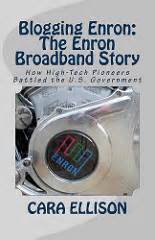
The Enron story has provided material for research and discussion of business ethics, classroom study, and fiction and nonfiction about the world of corporate finance.

The online trading systems were involved in the financial misrepresentation and other questionable financial behavior that eventually led to Enron's demise.

The resulting energy markets made it possible for companies like Enron to thrive, while the resultant price volatility was often bemoaned by producers and local governments.
